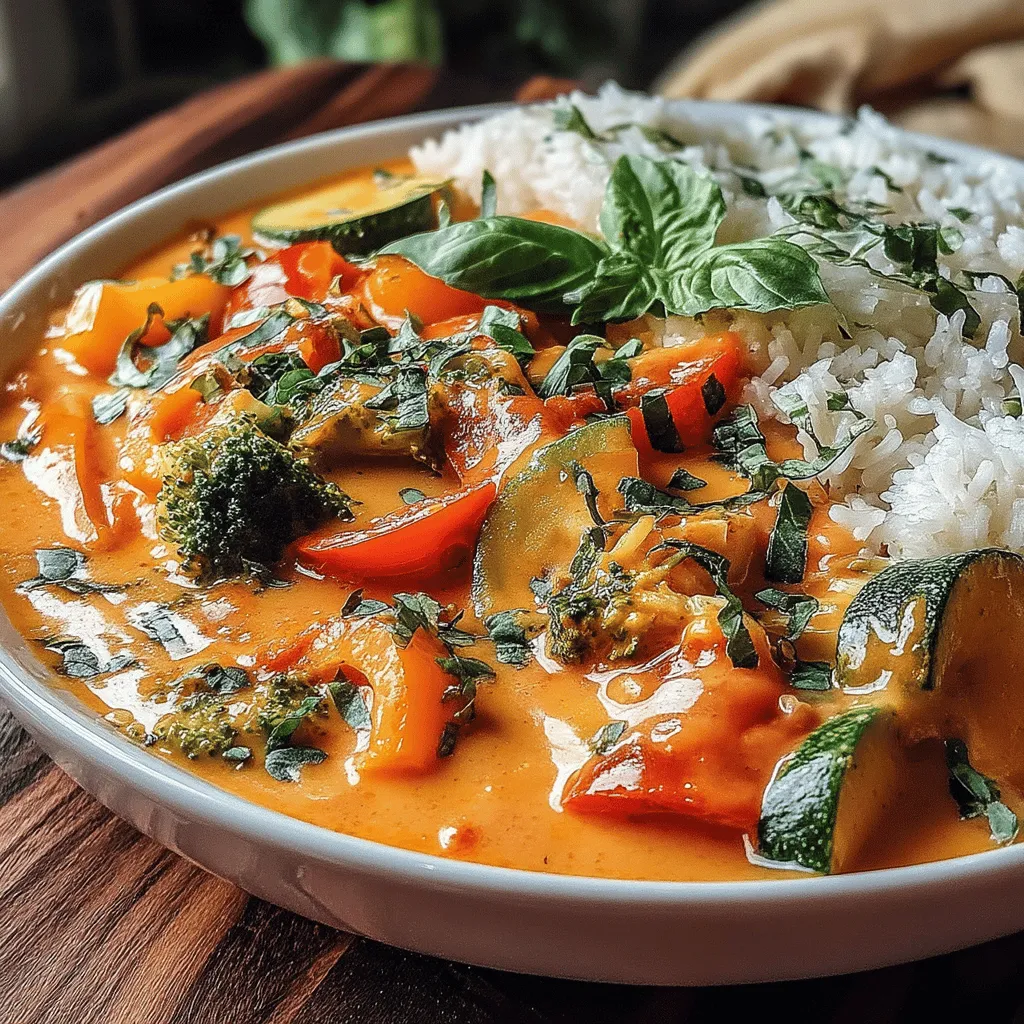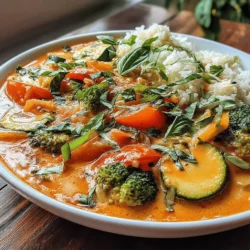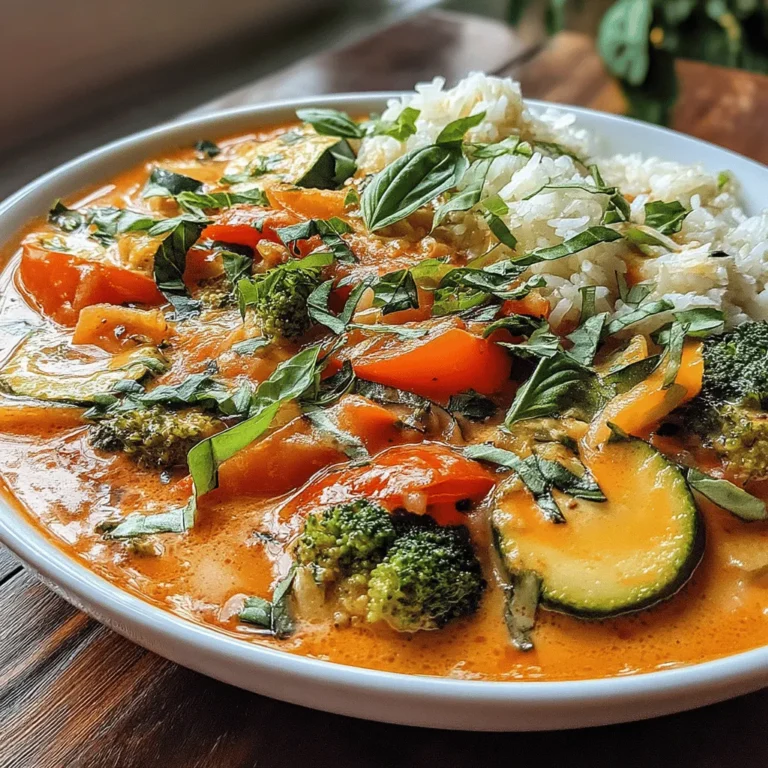Introduction
Exploring the vibrant flavors and aromatic spices of Thai cuisine can be an exhilarating experience for food lovers. One of the standout dishes that encapsulate these elements is the Thai Red Curry, celebrated for its rich, creamy coconut base and an array of colorful vegetables. This article will guide you through making a delightful Vibrant Vegetable Thai Red Curry, perfect for both novice and seasoned cooks. Not only will you learn how to prepare this dish, but you will also understand the health benefits of its ingredients and the cultural significance of Thai curry.
The essence of Thai Red Curry lies in its balance of flavors—sweet, spicy, sour, and salty—all harmoniously blending together. With fresh vegetables and aromatic spices, this dish not only tantalizes the taste buds but also serves as a nourishing meal option. Get ready to elevate your culinary skills and immerse yourself in the captivating world of Thai cooking.
Recipe Overview
– Total Time: 40 minutes
– Servings: 4
– Difficulty: Easy
Ingredients
– 1 tablespoon vegetable oil
– 1 onion, thinly sliced
– 3 cloves garlic, minced
– 1 tablespoon Thai red curry paste
– 1 can (14 oz) coconut milk
– 1 cup vegetable broth
– 2 cups mixed vegetables (bell peppers, zucchini, carrots, etc.)
– 1 cup broccoli florets
– 1 tablespoon soy sauce
– 1 tablespoon brown sugar
– Fresh basil leaves, for garnish
– Lime wedges, for serving

Instructions
1. Heat the vegetable oil in a large pot over medium heat. Add the sliced onion and sauté until translucent, about 3-4 minutes.
2. Stir in the minced garlic and Thai red curry paste, cooking for another 1-2 minutes until fragrant.
3. Pour in the coconut milk and vegetable broth, stirring to combine.
4. Add the mixed vegetables and broccoli florets to the pot, bringing the mixture to a gentle simmer.
5. Stir in the soy sauce and brown sugar, adjusting the seasoning to taste.
6. Allow the curry to simmer for 15-20 minutes, or until the vegetables are tender.
7. Serve hot, garnished with fresh basil leaves and lime wedges on the side.
Understanding Thai Red Curry
The Origins of Thai Curry
– Historical background of Thai cuisine
– Importance of curry in Thai culture
The Ingredients and Their Benefits
– Overview of core ingredients in Thai red curry
– Nutritional benefits of coconut milk, vegetables, and spices

Serving Suggestions
Traditional Accompaniments
To elevate your Vibrant Vegetable Thai Red Curry, consider serving it with traditional accompaniments. Jasmine rice is the classic choice, providing a fragrant and fluffy base that perfectly absorbs the rich and spicy curry sauce. Alternatively, quinoa offers a nutritious, protein-packed option that complements the dish well, especially for those seeking a gluten-free alternative.
You can also pair your curry with other Thai dishes, such as fresh spring rolls or crispy tofu, for a more elaborate meal. These sides not only enhance the dining experience but also introduce a variety of textures and flavors, making your meal even more delightful.
Presentation Tips
The presentation of your Thai Red Curry is an essential aspect that can significantly enhance the dining experience. Consider garnishing your curry with fresh basil leaves, cilantro, or thinly sliced red chili for a pop of color. A sprinkle of toasted sesame seeds or a wedge of lime on the side can add both visual appeal and an extra layer of flavor.
Remember, the importance of visual appeal in food cannot be understated. A beautifully presented dish not only stimulates the appetite but also shows the care and effort put into the meal, making it more enjoyable for everyone at the table.
Variations of Thai Red Curry
Customizing Your Curry
One of the best features of Thai Red Curry is its versatility. You can easily modify the recipe to suit various dietary preferences. For a vegan option, ensure you use plant-based proteins such as tofu, tempeh, or chickpeas. If you’re gluten-sensitive, check that your curry paste is gluten-free or make your own at home.
Additionally, feel free to experiment with different vegetables based on what’s in season or your personal favorites. Bell peppers, zucchini, and eggplant can all be great additions, while proteins like shrimp or chicken can be incorporated for a meatier version of the dish.
Regional Variations in Thailand
Exploring different regional variations of Thai curry can provide insight into the rich culinary landscape of Thailand. For instance, Massaman curry, influenced by Indian flavors, tends to be milder and is often made with meats and potatoes. In contrast, Green curry is known for its vibrant color and spiciness, typically featuring green chilies and a variety of fresh herbs.
Comparing Thai curries with other Asian curries, such as Indian or Japanese, reveals unique attributes and flavor profiles. Each curry offers a distinct taste experience, showcasing the diversity of ingredients and cooking techniques across cultures.
Health Benefits of Vibrant Vegetable Thai Red Curry
Nutritional Analysis
Vibrant Vegetable Thai Red Curry is not only a feast for the senses but also a nourishing option packed with nutrients. With a significant amount of vegetables like carrots, bell peppers, and spinach, this dish is rich in vitamins A and C, as well as essential minerals. The plant-based nature of the curry provides a low-calorie meal that is high in dietary fiber, promoting digestive health.
Engaging in a plant-based diet can lead to numerous health benefits, including reduced risk of chronic diseases, improved heart health, and better weight management. Incorporating more plant foods like this curry into your diet can be a delicious way to enhance your overall well-being.
Mindful Eating
Preparing and enjoying your Vibrant Vegetable Thai Red Curry can have mental and emotional benefits. Cooking at home allows you to connect with your food, fostering mindfulness and appreciation for the ingredients you use. Taking the time to savor each bite encourages a more profound relationship with your meals, promoting feelings of satisfaction and contentment.
The concept of balance in meals is vital. By combining a variety of vegetables, healthy fats, and proteins, you create a nourishing dish that satisfies both body and mind, leading to a more holistic eating experience.
Conclusion
Creating a Vibrant Vegetable Thai Red Curry not only delights the palate but also nourishes the body with its wholesome ingredients. This dish serves as an excellent example of how simple and fresh components can come together to create something truly special. By understanding the techniques and cultural significance behind this recipe, you can appreciate the artistry of Thai cooking while enjoying a delicious meal that brings color and flavor to your table.


